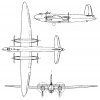View attachment 590117
Not a problem as you can see torpedoes tended to be carried pointing down
Hence the Torpecker.
View attachment 590117
Not a problem as you can see torpedoes tended to be carried pointing down
The Tornado will fill that role and anyway the Typhoon didn't do anything the Hurribomber couldn't have.That's a real shame, while it makes sense in context and they weren't great fighters they were fantastic in the tactical air support role.
The Tornado will fill that role and anyway the Typhoon didn't do anything the Hurribomber couldn't have.
This is much more likely,Is an autogyro, such as the Cierva C.30 too radical for the artillery spotter role?

A wide body version to carry 20 troops (two rows of folding bench side seating with exit/load doors either side)? Should be less than the 2000Kg payload.Armstrong Whitworth Albemarle, initial production to commence first quarter 1941, Training and transport version to take priority.



Is a Super Ensign with Hercules engines feasible?A wide body version to carry 20 troops (two rows of folding bench side seating with exit/load doors either side)? Should be less than the 2000Kg payload.
I just thought that given the only difference is a greater priority on transport, the cargo/pax volume should increase. Peerless ministry without a crystal ball. Yet looking at the Ensign, I can't see why a military transport version couldn't happen. Not the best, even with the Cyclone engines of the MkII. It is all up to @sonofpegasus I'm just pitching ideas too. The Lancaster (and York) come a little later I think.Is a Super Ensign with Hercules engines feasible?
IOTL AW built Lancasters. Could it have built Yorks instead of the Albermarle? They might have to have Hercules engines instead of the Merlin, but IOTL Armstrong-Whitworth did build the 300 Lancaster Mk IIs that had Hercules engines.
That was being worked on before the war in Shorts I beliveHmmm I wonder if the RAF can figure out practical aerial refueling sometime during the war as it would be rather handy indeed
I do not wish to run too far ahead, But the early Albermarles will be basically stripped out bombers (good as glider tugs and training aircraft) The Mark II if built (probably with a different name) would have a wider fuselage two rear doors and even possible a small ramp. visually it would look in profile like an Albamarle with the cockpit moved forward over the nose wheel and the hi line of the fuselage continued aft from where the dorsal gun turret was and the tail raised to this new line. The weight of the new cockpit is counter balanced by the extended rear roofline, overall weight gain is somewhat mitigated by the removal of the gun turret and the rear guns. Think of it as a mini Caribou.
A transport Envoy would be created by stripping out all the separate cabins and their fittings and replacing them with a single cabin floor conforming to the fuselage shape, adding twin rear doors aft for rapid troop drops.
There will be a future update detailing my ideas for Transport Command.